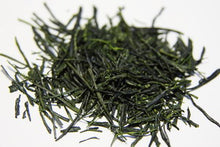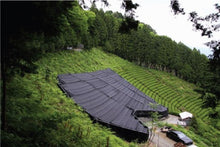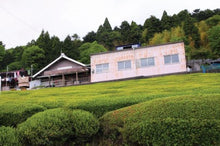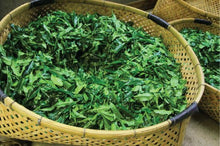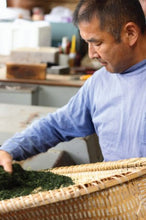
Gyokuro is regarded as the King of Japanese green tea.
Usually, when talk about Gyokuro, it reminds us of "seaweed-like" flavor as the identical flavor of a Gyokuro. Nevertheless, this is a rare Gyokuro that produced from high altitude in Japan. It gives a sweet nutty note like Idamame, with a hint of seaweed-like undertone.
When talk about Gyokuro, the Japanese always associate it with three famous places: Kyoto-Uji, Fukuoka-Yame and Shizuoka Okabe Asahina. In fact, these three places are located at lower altitudes, at around 100-300m. In general, people always appreciate tea from much higher altitude as those teas are giving very long-lasting aftertaste compared to the one from low land. Gyokuro from these places are famous due to the Japanese culture that people in the tea line tend to emphasize the “seaweed aroma” and amino-rich taste rather than the “long-lasting aftertaste”.

Hon Yama Hebizuka Gyokuro does not come from any of the places mentioned above. It is produced in Hon Yama, Shizuoka City. Hon Yama area is located deep inside the mountain along the Abe river stream. It is a historically famous tea growing area since the Edo era. The fame of Hon Yama tea reached its climax thanks to Shogun Tokugawa Ieyasu who always adhered to Hon Yama tea.
In Hon Yama, manufacturers are able to produce high quality tea thanks to the ideal growing environment in this area. In particular, “Hebizuka” is located at one of the highest peak in Hon Yama (about 800m). Due to the high altitude, winter comes earlier and spring comes later. The winter period in Hebizuka is two months longer than the ordinary tea garden at lower altitude in Shizuoka. The additional resting period allows tea to absorb and accumulate more minerals. The tea will then give a richer taste and flavor that lasts for a long time.
At first, I wondered why the manufacturer produces Gyokuro despite Hebizuka in Hon Yama is a promising production area of fine Sencha.
When I met the manufacturer and tasted his tea, I got the answer. He dared to produce Gyokuro in the middle of the primary Sencha production area only because he has a confidence with its identical cup characteristic and its quality.
There is another point that makes Hebizuka Gyokuro very special and different from ordinary Gyokuro. Its production involves a very unique process. Hebizuka Gyokuro undergoes the “withering process” which is rarely carried out in the process of Japanese green tea. Usually, the withering process is an essential process in making oolong, black tea and white tea. Withering means dehydration of tea leaves which is the similar process in making dried flower and different from faded flavor. The withering process deliberately causes the dehydration shock that triggers enzymatic ripening and generate floral flavor in the tea leaves.
Plucking is carried out when the tea leaves grow slightly more than ordinary standard. Late plucking is purposely done so that tea leaves increase the amount of poly phenol. It is the same practice in making the oolong tea that requires more poly phenol content in order to intensify the flowery flavor. Leaves that are plucked at the very early stage contain less organic substance and the intensity of flavor is relatively weaker.
Hon Yama Hebizuka Gyokuro is the tea that is made by the collaboration between fine material from the High Mountain and unique process which involves withering. The flowery flavor and the deep after taste of Hebizuka Gyokuro are unforgettable once you drink it.

1. History and Culture of Hon Yama Hebizuka Gyokuro
The literature (東福寺志) stated that the first tea bush in Hon Yama was seeded by a monk during the Kamakura era (year 1244). According to the oldest record of Japanese tea written in 1211 by a monk named Ei Sai (栄西), Hon Yama tea was one of the oldest teas in Japan.
The tea produced along the Abe River was usually meant for the high-end market in Japan. In order to differentiate their quality from ordinary green tea, the name Hon Yama was given as a brand to represent its premium quality. The fame of Hon Yama tea reached its climax thanks to Shogun Tokugawa Ieyasu who founded the Edo Era. According to the records, the Shogun Tokugawa constructed the tea store deep inside the mountain at the upstream of Abe River in order to maintain the quality of his tea.
Hebizuka is the name of the mountain located at the highest point of Hon Yama area. It is a very small area where only 10 families stay near the peak of Hebizuka. Out of 10 families, only a few families are involved in the tea business. In Hebizuka, the person who plant tea is also in charge of making tea. Each family has a small tea making facility that is attached with their own house. Our Hon Yama Hebizuka series is made by the Nakamura family. Out of Hebizuka area, Mr. Nakamura is the only one who produces Gyokuro. According to him, the production of Hebizuka Gyokuro had been started by his father who studied the basis of Gyokuro from Okabe town. Taking the advantages of high altitude of Hebizuka area and the iron-rich soil condition, he came up with a very unique Gyokuro by the name of the Nakamura family.

Hon Yama Hebizuka Gyokuro
2. Production Area - Hon Yama
Shizuoka tea is very famous in Japan. But there are two different kinds of Shizuoka tea. Basically, the tea garden of Shizuoka is differentiated into two kinds as follows:
A: Mountain tea developed along the Southern Alps
The tea garden is at a higher elevation. Each garden produces quality tea rather than the quantity.
B: Tea produced on the hill or slope
This is relatively located at lower elevation as compared to the mountain area.
The tea gardens are developed in a larger scale. The production of tea is meant for quantity, although they also maintain certain level of quality. The tea garden and the processing are well-taken care of. However the material is not as superior as mountain tea.
Hon Yama is classified as mountain tea. Each tea garden is kept in a small scale and managed by respective families. The majority of the tea gardens are located at the steep slope of the mountain. The name of Hon Yama Tea is applied for the garden that is situated along the Abe River stream. Abe River flows from Japan Southern Alps (3000m above sea level). It takes 50 over kilometer to reach the Pacific Ocean.
Hebizuka tea is also one of the Hon Yama Tea. Hebizuka is the name of the peak that is located at the upper stream of Abe River. The altitude of Hebizuka is at around 750-800m. Due to the high latitude of Japan, the tea tree cannot survive over the winter if it is grown at an altitude more than 1000m above sea level. Considering that, the altitude of the Hebizuka tea garden is almost the growing limit of tea in Shizuoka.
In Hebizuka, due to the high altitude, spring comes a month later and winter comes a month earlier than ordinary tea gardens in Shizuoka. Eventually Hebizuka has an additional 2 months of resting period in winter. The longer resting period helps tea to accumulate minerals. Therefore, the first up-coming tea leaves are very rich in mineral and give a strong after taste and you can also enjoy the flavor that slowly meanders down the throat. On the other hand, the tea tree planted at lower elevation contains less mineral and therefore it lacks the depth of after taste and flavor, although it gives a strong aroma. The quality of tea is in proportion to the intensity of after taste. The long resting period is an essential factor to produce the fine quality.
Despite of high quality of Hon Yama Hebizuka Gyokuro, the price of this tea in the market is comparatively low. In Japan, the earlier the new season tea is introduced, the higher the price. It is due to the culture of the Japanese who always appreciate the fresh products. The first batch of Japanese green tea is produced in the middle of April. This is the time when everyone is aware of the new tea season. Basically the most of the tea gardens in Japan finish their harvesting by the first week of May. However, in Hebizuka area, due to the higher elevation, the spring comes one month later. The plucking of the first flush is only started in the middle of May. This is exactly a month later than the first spring tea in the market. After all, the tea market in Japan does not appreciate the late harvest tea and eventually gives a lower price even if tea is extremely of high quality. The farmer, Mr. Nakamura is very much aware of this fact. He produces not only Sencha, but also Gyokuro and supplies it to the respective tea company who understands its quality and appreciates his tea. Considering that Hon Yama Hebizuka is only produced by Mr. Nakamura, it is a very limited tea. Only a few companies have the privilege of dealing with his tea.
In fact, there is another factor that makes Hebizuka tea very special. The name of Hebizuka in Japanese is “The Grave of Snake”. When you have a chance to visit the Hebizuka area, you will spontaneously associate the name with its geographical condition. Hebizuka area has many rocks and its appearance resembles those seen in Yi Xing (China), Sado Island and Iga Mountain in Japan. They are all purple, yellow or red in color. If those rocks are found in Yi Xing, people no doubt think these are purple sand: Zisha that used as the material to produce the famous Yi Xing tea pots. The colors of rocks indicate that the soil in Hebizuka is very rich in “Iron” content. Iron is the most essential mineral that contribute to the after taste of tea.
In addition, the mineral-rich soil is very poor in nutrition and fast to drain water. Under such restricted environment, tea grows slowly. As a result, the flavor and taste is highly concentrated inside the tea leaves that gives a very rich flavor and strong after taste.

3. Cultivar and Plucking
Hon Yama Hebizuka Gyokuro is produced from Yabukita cultivar. Plucking is carried out only once a year in the middle of May. Thanks to the limited number of plucking, the mineral content in the tea leaves are much higher than ordinary tea. The tea leaves are hand-plucked. Each twig consists of one bud and two leaves.
Hon Yama Hebizuka undergoes the withering process in order to enhance its floral character. In order to maximize the effect of withering, the tea leaves needs a higher percentage of poly phenol. In order to convert amino acid into poly phenol, the tea leaves will not be harvested until it grows to a bigger size than ordinary Gyokuro. During the withering process, poly phenol will be converted into various kinds of volatile substance that contributes to the floral flavor of Hebizuka Gyokuro.
Plucking starts after the sunrise in order to avoid the morning dew. The present of morning dew on the tea leaves will cause partial over-heating during the steaming process. This will destroy the tissues of tea leaves and affects the quality. Therefore, good Gyokuro must be produced from tea leaves which are plucked during a sunny day.

Likely to normal Gyokuro, the Gyokuro garden is covered with black cloth. Due to the limited amount of sunshine, Gyokuro leaf get immune as it increases the size of leaf and increases the number of chlorophyll in order to effectively capture the sun light and carry out necessary amount of photo synthesis.
Around 30 days in advance before plucking the leaves, the tea garden of Gyokuro is covered with a black sheet. The penetration rate of sunshine in the beginning which is for 7-10 days is 65-70%, and from then onwards is 97-98%.
The theanine which is a kind of amino acid is produced from the root and is transferred to the stem and leaves. Theanine is the substance representing the umami and sweetness in green tea. Green tea which contains higher percentage of theanine gives a mellower taste, on the contrary, tea leaves which contain a higher proportion of polyphenol such as catechins gives a bitter taste.
When tea leaves are exposed to sufficient sunshine, theanine is degraded and converted into catechins. Therefore, blocking out the sunshine will inhibit the biosynthesis of catechins and subsequently theanine is proportionally increased. In other words, the typical taste of Gyokuro is made by blocking out the sunshine from the tea leaves.
Typical aroma of Gyokuro which is often associated as seaweed is composed by the substance named dimethylsulphite. The precursor of dimethylsulphite is called methylmethioninesulphonyl. This substance is also accumulated in tea leaves when the tea garden is blocked from sunshine. During this process, the tea leaves get steamed, which in turn produces a substance called dimethylsulphite.
The brewed Gyokuro leaves are very deep green in color compared with Sencha which is yellowish green. When the tea garden is covered and no sufficient sunshine reaches the tea leaves, it will rise to the surface of the tea leaves and produce more of chlorophyll which is the green pigment of tea leaf, in order to carry out photosynthesis. This is the reason why the color of Gyokuro is a deep green shade.
4. Processing
(1) Receiving the tea leaves
Mr. Nakamura owns a very limited number of tea gardens. Basically the tea leaves are not mixed. Hon Yama Hebizuka Gyokuro is processed from the single origin of the identical tea garden. His teas are all hand-plucked without using the machinery. Everything is done manually.
(2) Withering
After plucking, the tea is gently placed inside a small bamboo basket. A hole is made in the middle of piled tea leaves to provide effective ventilation. Withering process is carried out under the shade with good ventilation for 24 hours. During the withering process, internal enzyme is triggered to start the ripening. It is the same mechanism as hanging unripe pineapple for further ripening. Another example is that hay usually gives a sweet aroma, while grass gives a very greenish aroma right after being cut. These involve the same mechanism.
The enzyme is triggered by dehydration and mediate moderate ripening process. Ripening is a kind of oxidation or enzymatic hydrolysis that produces various kind of volatile substance. In tea leaves, those volatile substances give a floral aroma and flavor.

(2) Steaming
The quality of Gyokuro is also affected by the steaming process. In order to bring out the identical character of this tea, the steaming process is conducted at a very short time, about 30 seconds. Tea leaves are steamed at a very high temperature but in a short time so that it become very dry and will not regain the moisture by condensation. This is one of the key points to produce good quality teas.
(3) Cooling
Tea leaves have to be cooled down quickly after steaming. Immediate decrease of the wet heat is very important to avoid secondary heating of tea leaves. At the same time, the tea leaves will evaporate the moisture.
(4) Pre -rolling
Tea leaves are agitated with hot air for further drying. At the same time, the mixing will soften the leaves.
(5) Rolling
This is the only process conducted without heat. The machine moves in a circular motion with pressure that spread the moisture of tea leaves evenly. The tea leaves generate heat due to the friction. Therefore, it is necessary to loosen the tea leaves and release the heat at regular intervals.
(6) Intermediate Rolling
A rotary dryer is used to roll the tea leaves gently and twist the tea leaves into a finer shape. It is also part of the drying process to further reduce the moisture of tea leaves.
(7) Final Rolling
It is a reciprocal movement of back and forth; combine with a circular motion to twist the tea leaves into a fine needle shape. High quality Gyokuro is dark green in color, shinny and solid.
(8) Drying
After the final rolling, the tea leaves still contain moisture. Drying will reduce moisture to about 5%. These leaves are called Aracha (crude tea). Aracha does not undergo the firing process. Compared with the finished tea product, the flavor of fresh leaves and bitter taste is very strong.
5. Hojo Standard Brewing Method
The characteristic of Gyokuro is deep umami and sweetness. It is very thick and has a soupy like consistency, with a very sweet after taste. Please note that the brewing method of Gyokuro is very different from Sencha.
Water
In you are using tap water, it is necessary to filter the water using an activated carbon filter. If not, you wouldn’t be able to enjoy the authentic taste of tea. Chlorine is added to tap water in order to sanitize bacteria. This chlorinated water will also harm our body cells. Concerning about our health condition, it is very important to remove chlorine from drinking water. The most effective method in removing chlorine is to install an activated carbon filter. This type of filter is designed for removing organic substance. It will remove not only chlorine, but also other harmful substance such as contaminated pesticide. The activated carbon filter can be easily obtained from the common hardware shop in most countries. If activated carbon filter is not available, please place a charcoal inside the water and leave it for over night. The material composed of activated carbon filter is made of ground charcoal. The difference is that activated carbon filter contains much finer particles and hence it has extremely large surface area for a better efficiency in filtration. We do not suggest RO water (reversed osmosis water) or distilled water. This water carries no mineral, the taste and flavor of tea tends to be very unstable, unless you have very superior quality tea and tea equipment.
It is also advisable not to use fresh tap water. The intensity of after taste becomes stronger if water is kept overnight. Keeping water with stones or inside clay jar will increase the content of minerals. However, you need to confirm whether or not the water kept inside particular jar or with stone is suitable with your tea or tea equipment (such as teapot). If water jar carries certain minerals like copper or zinc, it will rather spoil the taste and flavor of tea. For this, you need to confirm with experiment on try and error basis.
For boiling water, please do not use aluminum or copper kettle. It spoils the taste of water. We suggest using kettle made of iron, stainless steel, tin or glass.
In the long run, you may observe a thick layer of scale accumulated inside your kettle. Our mother usually taught us to wash and remove it with citric acid. But please do not even try to remove the scale. Scale consists of minerals that exist in the water. The mineral composition is reflected from the water you used. If you remove the scale, the mineral ion balance between scale and water is destroyed. This balance is called buffer effect in science. The flavor and taste will seriously run out and you won’t be able to get previous taste and flavor for a long time. It is also important to stick to the same type of water whenever brewing tea. If source of water is changed, it carries different type of minerals. It will affect the mineral ion balance too.
We recommend 2 different styles of brewing:
1. Traditional style
2. Modern style.
The traditional style uses less water, extremely low water temperature and long brewing time. It gives a very thick taste like soup and strong body. As for modern brewing method, we follow almost the same method as brewing sencha. We use less quantity of leaf, higher water temperature and a shorter brewing time than brewing sencha. It gives a very strong flavor and a gentle sweetness of taste. Based on my experience in serving Gyokuro to many customers, the majority of my customers enjoy the Gyokuro brewed in the modern style. Nevertheless, I suggest you to take the challenge to brew Gyokuro in traditional style, at least once; it will be your true experience with this authentic Japanese Green Tea Espresso.
Traditional Brewing Method
The volume of water and the quantity of tea leaf
Use about 6g of tea leaves for 100ml of water. Tea is served in very high concentration.
Temperature
It is important not to use boiling water. Boiling water should be poured into an empty glass or any container and let it cool down until about 50 degree Celsius. It is as low temperature as shower.
Brewing time
The brewing time is about 2 minutes. The second brewing is less than 10 seconds at the same temperature. Customer tends to feel that less than 10 seconds may not be long enough. However it is sufficient since tea leaves have been soaked in hot water for 2 minutes in the first brewing. Second brewing is the most critical brewing. If you brew too long at 2nd brewing, you would not be able to enjoy the tea from the rest of brewing.
Serving method
Traditionally, a pitcher is not used for brewing Japanese tea. Tea is directly poured from the tea pot into respective tea cups. In order to make the concentration even, we have to pour one cup after another, a few times until the last drop of tea. The purpose of pouring until the last drop is to extract the concentrated liquor. This is important as tea leaves must be filtered well and kept without water to avoid the liquor becoming bitter and stewed. Besides, it prevents tea leaves from being over cooked. In addition, tea after filtration will be ready for second brewing. However the usage of pitcher is highly recommended as it is very practical for brewing a nice cup of tea. With the pitcher, you will be able to keep the teapot always empty as soon as brewing is completed.
After pouring the tea, you have to make sure leave the lid open to avoid further steaming of tea leaves.
The suitable equipment
Banko purple clay and Tetsubin makes the taste of Gyokuro even better. It is mainly because of the iron that released from the equipment. In particular, the iron enhances the depth of after taste.
Modern Brewing Method
The volume of water and quantity of tea leaf
The quantity of tea leaf can be calculated by a formula that "Divide the Volume of Water by 5". For example: the volume of teapot = 200ml; 200ml/50 =4g. You need to measure 4g of tea leaves for 200ml of water. As opposite to the traditional brewing method, the modern style uses more volume of water. A teapot with the size about 150-220ml is just nice for one person.
Temperature
Cool down the boiling water to 70-80 degree Celsius. Use the same temperature for a series of brewing until you feel the taste no long remains. Finally, you can use boiling water to bring out the remaining taste and flavor.
Brewing time
Gyokuro leaves are much tenderer than sencha leaves. Brewing time should be slightly shorter than when we brew sencha. For sencha, the first brewing period is 1 minute. For Gyokuro, 30 seconds to 40 seconds is long enough. The second brewing must be less than a few seconds. The third brewing is the same. From the forth brewing onwards, increase to additional 10 seconds for the each subsequent brewing.
Suitable Tea Equipment
Banko purple clay and Tetsubin makes the taste of Gyokuro even better. It is mainly because of the iron that is released from the equipment. In particular, the iron enhances the depth of after taste. For this brewing method, we also recommend to use a red clay teapot. With higher water temperature, the aroma and flavor of Gyokuro is more intense which synchronizes with the character of red clay.
Cold Water Brewing Method
Most of Green Teas can be brewed in cold water. The higher the grade of tea, the more suitable it is with cold water brewing. In particular, Gyokuro is second to none when it comes to the cold water brewing.
Brewing method using the large container
1. Measure 1 table spoons of tea leaves for 500ml of water.
2. Pour the water into a glass jar or bottle and leave it for more than 30 minutes. It is also a good idea to put the tea leaves directly into a PET bottle.
3. Gently sway the container in order to get an even concentration.
4. Usually the taste of tea gets thicker when it is brewed for more than a few hours. In this case, pour in additional water. Eventually tea can be brewed more than 1 liter per 1 table spoon of tea leaves.
Brewing method using a clay teapot
1. Measure 4-6g of tea leaves for 200ml of water.
2. Pour water into a clay teapot and brew for 3 minutes.
3. For second brewing, brew for 20 seconds. Alternatively you can also switch to hot water from second brewing onwards, if you wish. If using hot water for second brewing, pour boiling water and brew for less than a few seconds. Since tea leaves are very cold and wet, the temperature drastically drops to less than 60 degree Celsius.
The benefit of cold water brewing is tea can last for a whole day and the taste is refreshing with a natural sweetness. Thanks to the cold water extraction, the level of caffeine in tea is very low. You would not suffer from sleepless nights. Even kids can enjoy this tea.





